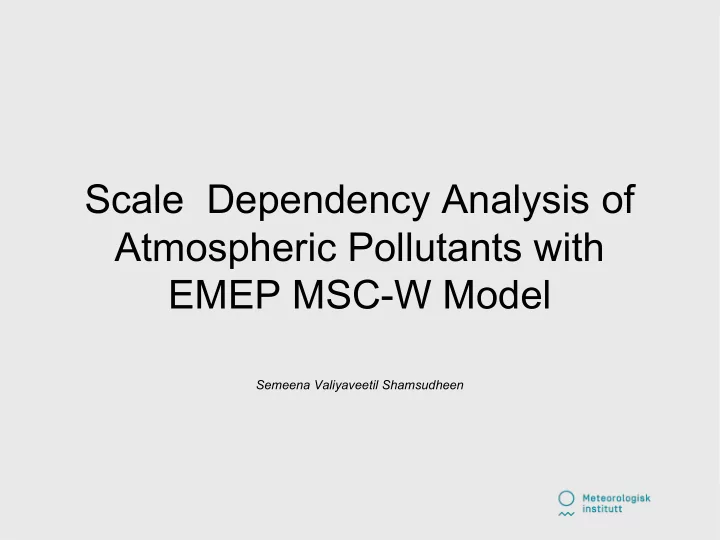

Scale Dependency Analysis of Atmospheric Pollutants with EMEP MSC-W Model Semeena Valiyaveetil Shamsudheen
Bias % = Model - Obs Model Validation ´ 100 Obs Component No. of Obs Bias% Bias% Bias% Bias% Corrn Corrn Corrn Corrn Stns 56 28 14 7 56 28 14 7 22 1.92 -11 -12 -13 -15 .85 0.87 0.87 0.87 NO3 in air ug/m3 1.72 1.70 1.68 1.67 HNO3 in air 13 0.17 -27 -28 -21 -22 0.49 0.54 0.52 0.54 0.12 0.12 0.13 0.13 ugN/m3 Ammonia in 43 1.62 -30 -28 -30 -24 0.69 0.66 0.72 0.72 air ugN/m3 1.14 1.17 1.13 1.17 63 14690 -7 -5 -6 -6 0.80 0.77 0.78 0.77 Nitrate wd 13621 13937 13818 13798 mgN/m2 Amm wd 62 17015 -2 2 2 4 0.66 0.62 0.63 0.63 mgN/m2 16624 17379 17416 17773 63 0.28 -7 -8 -8 -9 0.65 0.67 0.66 0.66 Nitrate in pptn mgN/l 0.27 0.26 0.26 0.26 Amm in 62 0.34 -3 -2 -1 0 0.54 0.50 0.51 0.50 0.33 0.33 0.34 0.34 pptn mgN/l http://emep.int/publ/reports/2013/MSCW_technical_1_2013.pdf
Time series of Oxidised Nitrogen
Computer requirements HP BL 460c Gen 8 cluster, 518 nodes, 32GB memory each --> ~3.30 hr for 50 x 50, 1 yr SGI Altix 8600, 1440 nodes, 32GB memory each --> ~3 hours for 50X50km, 1 yr.
EMEP Monitoring network and Data Uncertainties
EMEP Monitoring Network Denmark - 12 Germany - 30 Poland - 5 Latvia - 3 Lithuania - 2 Estonia - 3 Russia - 7 Finland - 18 Sweden - 18
Data quality and uncertainities ● In the data quality objective (DQO) of EMEP measurement program, there is a requirement that the measurements should be within 15-25% uncertainity for the combined sampling and chemical analysis. http://www.nilu.no/projects/ccc/qa/ ● We have annual laboratory intercomparisons which check the performance in the laboratory and these are generally very good, within 5-10% uncertainity for S and N components. However the main uncertainity is in the field, whether it is used bulk or wet only, collection efficiency (should be checked with parallel rainguages, but few sites report this), sampling intervals (higher uncertainity for longer periods, especially longer than weekly) etc. http://www.nilu.no/projects/ccc/intercomparison/info.html
Data quality and uncertainities ● To asess the real uncertainity in the field measurements, you need parallel sampling, i.e., field intercomparison. CCC had conducted some of these in the past, at NO01 and PL05 the uncertainities in the wet deposition of SO4 and NO3 is better than 10% http://www.nilu.no/projects/ccc/qa/ ● Finally it is upto the parties to report the data within the requirements set by the programme. CCC do check the data quality by annual laboratory intercomparison and field intercomparison. Further a time series and ion balance plots were prepared to get a more subjective feeling of the data quality. http://www.nilu.no/projects/ccc/ionbal/index.html ● Before CCC used to write annual report on the data quality where also the Parties reported on the uncertainties of their measurements. The last one was in 2006 http://www.nilu.no/projects/ccc/reports/cccr3-2008.pdf Wenche.aas@nilu.no
Recommend
More recommend